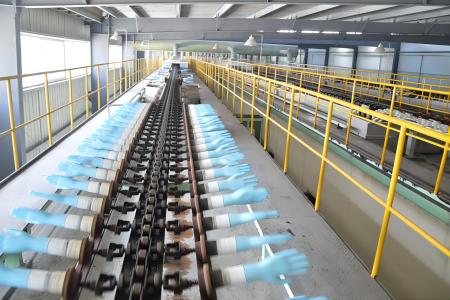Nitrile Glove Manufacturing Process
Published on 2023/6/8

Share to:
Nitrile Glove Manufacturing Process
From the materials used to the intricate steps involved, we will uncover the science behind the production of nitrile gloves.
Nitrile gloves have become an essential item in our daily lives, especially in the current global situation, where sanitation and hygiene are more critical than ever before. These gloves have proven to be a reliable barrier against harmful substances and microorganisms, making them an indispensable tool for healthcare professionals, food industry workers, and individuals looking to stay safe and healthy. However, have you ever wondered how nitrile gloves are made? What goes into the manufacturing process that makes them so effective? In this article, we'll take a closer look at the nitrile glove manufacturing process and explore how it works. From the materials used to the intricate steps involved, we'll uncover the science behind the production of these essential gloves. So, if you're curious about the process of creating nitrile gloves, sit tight and read on!
Raw Materials Used in Nitrile Glove Manufacturing
The first step in the nitrile glove manufacturing process is identifying and procuring the raw materials needed to make the gloves. The main component of nitrile gloves is nitrile rubber, a synthetic material made from petroleum. Nitrile rubber is known for its exceptional resistance to chemicals, oils, and punctures, making it an ideal material for gloves. Additionally, nitrile gloves are often made with other materials, such as latex, vinyl, or neoprene, to enhance their properties and make them more comfortable to wear. These materials are sourced from various suppliers worldwide, and the quality of the raw materials is critical to the final product's quality.
Once the raw materials are procured, they are tested for quality and purity before being used in the manufacturing process. This ensures that the gloves produced are of the highest quality and comply with international standards.
Mixing and Compounding
After the raw materials are tested and approved, they are mixed and compounded to create the nitrile rubber that will be used to make the gloves. The mixing and compounding process involves blending the raw materials with various chemical additives, such as accelerators, antioxidants, and stabilizers. These additives help to improve the physical properties of the gloves, such as elasticity, durability, and resistance to chemicals.
The mixing and compounding process is done in a large mixer, where the raw materials and additives are added in precise measurements. The mixer blends all the ingredients together to create a homogenous mixture, which is then transferred to the production line for the next step in the manufacturing process.
The Production Line
The production line is where the nitrile gloves are formed and shaped into their final form. The production line consists of several machines and equipment, each with a specific function in the manufacturing process. The first machine in the production line is the dipping machine, which dips the hand-shaped molds into the nitrile rubber mixture. The molds are then slowly withdrawn from the mixture, allowing the rubber to form a thin layer around the mold.
The next machine in the production line is the coagulating machine, which helps to solidify the nitrile rubber layer around the mold. The coagulating machine uses a coagulating agent, such as calcium nitrate or aluminum sulfate, to solidify the rubber layer. The coagulating agent helps to create a stable and uniform layer around the mold, ensuring that the final gloves are of the highest quality.
Dipping and Coagulating
After the molds have been dipped and coagulated, they are washed and dried to remove any excess rubber or coagulating agent. The gloves are then removed from the molds, leaving behind a perfect replica of the hand shape. The gloves are then washed again to remove any remaining impurities or contaminants.
Once the gloves are washed and dried, they are put through a series of quality control tests to ensure that they meet the required standards. These tests include visual inspections, leak tests, and physical properties tests, such as tensile strength and elongation. Any gloves that do not meet the required standards are discarded, and the manufacturing process is repeated.
Vulcanization
The next step in the manufacturing process is vulcanization, where the gloves are cured to enhance their physical properties. Vulcanization involves subjecting the gloves to high temperatures and pressure, which causes the rubber molecules to crosslink, creating a more stable and durable rubber layer.
The vulcanization process is done in large ovens, where the gloves are subjected to temperatures of up to 200 degrees Celsius for several minutes. The high temperatures and pressure help to enhance the gloves' properties, making them more resistant to chemicals, oils, and punctures.
Quality Control and Testing
After the vulcanization process, the gloves are put through a series of final quality control tests to ensure that they meet the required standards. These tests include visual inspections, leak tests, and physical properties tests, such as tensile strength and elongation. Any gloves that do not meet the required standards are discarded, and the manufacturing process is repeated.
Packaging and Shipping
The final step in the nitrile glove manufacturing process is packaging and shipping. The gloves are packaged in sterile packaging, which helps to maintain their quality and integrity. The packaging is also labeled with important information, such as the glove size, material, and expiration date.
Once packaged, the gloves are shipped to various destinations worldwide, where they are used in a variety of industries, such as healthcare, food processing, and manufacturing.
Conclusion
In conclusion, the nitrile glove manufacturing process is a complex and intricate process that involves several steps and machines. From the raw materials used to the final packaging and shipping, every aspect of the manufacturing process is carefully controlled and monitored to ensure that the gloves produced are of the highest quality. The result is a reliable and effective barrier against harmful substances and microorganisms, making nitrile gloves an essential tool for healthcare professionals, food industry workers, and individuals looking to stay safe and healthy.


 WhatsApp
WhatsApp
Send us your message
You can send an email asking for the price and detailed information of this product. We will reply you as soon as we receive your email